 |
 |
 |
| |
Hospital Rates Rise With Age for Cancer, Cardio, Other Diseases in US HIV Group
|
| |
| |
IDWeek 2018, October 3-7, 2018, San Francisco
From Jules: At the 2016 Comorbidities Wk in Wash DC this study reported - Very high burden of certain comorbidities among older patients......In an aging citywide contemporary cohort of largely non-Hispanic black HIV outpatients, we found a high prevalence of metabolic comorbidities despite access to health care and the availability of newer ARV regimens with improved metabolic side effect profiles.....Among patients aged ≥70, 78% had ≥2 metabolic comorbidities, including 44% with exactly two comorbidities, 27% with exactly 3 comorbidities, and 7% with all four comorbidities....Each metabolic outcome was independently associated with either depression or anxiety/stress disorder....Having a nadir CD4 count <200 (vs. >500) was associated with greater odds of hypertension....There was evidence of hypertension, dyslipidemia, and multimorbidity among more than half of those aged 50-59 and a large majority of those aged 60+, and there was evidence for type 2 diabetes in approximately one-quarter of those aged 60+."
Up to Half in Older DC Cohort Not Treated for Metabolic Comorbidities - High Burden of Comorbidities in Inner City Washington DC - - (09/27/16)
---------------------------------------
Mark Mascolini
In people with HIV, hospital admission rates climbed with age for numerous non-AIDS diseases, including cardiovascular, pulmonary, endocrine, and kidney diseases, as well as cancer [1]. This large HIV Research Network analysis found non-AIDS infections the leading cause of hospitalization overall and in each age group assessed.
As the HIV population ages, patterns of non-AIDS comorbidities shift. HIV Research Network investigators would conducted this analysis noted rising prevalence of non-AIDS malignancies, cardiovascular disease, and end-stage renal disease. They conducted this study to assess overall and age-specific hospitalization rates in their 20,608-person, 14-site US HIV group.
The analysis involved people at least 18 years old in active care for HIV infection in 2014-2015. The researchers culled medical records to determine numbers of hospital admissions per diagnostic category indicated by ICD-9 codes. The researchers divided the population into 5 age groups: 2790 people 18 to 29, 3741 people 30 to 39, 5858 people 40 to 49, 5998 people 50 to 59, and 2221 people 60 or older. About three quarters of each age group were men. Proportions of blacks and Hispanics from the youngest to the oldest group were 60.7% and 16.5%, 45% and 26.3%, 42.1% and 23.4%, 43.7% and 17.6%, and 43.7% and 18.4%. Across the 5 age groups, two thirds to three quarters had a CD4 count above 350.
Non-AIDS-defining infections were the most frequent reason for hospital admission overall (21.3% of all causes) and in each of the 5 age groups. The next most frequent overall reasons for admission were cardiovascular disease (11%), psychiatric conditions (8.3%), endocrine disease (7.8%), pulmonary disease, malignancy, and renal disease. People in the 2 oldest age groups had the highest hospitalization rates for each of these conditions.
Multivariate negative binomial regression analysis determined that, compared with 18-to-29-year-olds, people 60 or older had significantly higher admission rates for non-AIDS infections (incidence rate ratio [IRR] 1.38) and cardiovascular disease (IRR 9.16). Compared with the youngest group, each of the 3 middle age groups had significantly higher admission rates for cardiovascular disease. Admission rates also climbed with age for cancer and for pulmonary, endocrine, and kidney disease--but not for psychiatric conditions.
The multivariate analysis uncovered several other significant associations: Women got admitted to the hospital more than men for non-AIDS infections (IRR 1.28). Blacks got admitted more than whites for cardiovascular disease (IRR 1.51), and Hispanics got admitted more than whites for non-AIDS infections (IRR 1.30). Compared with people infected with HIV heterosexually, those infected while injecting drugs had a higher admission rate for non-AIDS infections (IRR 1.31) and psychiatric conditions (IRR 1.98). Compared with people who had an undetectable viral load, those with a detectable load had higher admission rates for non-AIDS infections (IRR 1.67), cardiovascular disease (IRR 1.47), and psychiatric illness (IRR 1.98). Compared with a CD4 count above 350, three brackets of lower CD4 counts were consistently associated with a higher admission rate for both non-AIDS infections and cardiovascular disease.
On the basis of these findings, the HIV Research Network team advised that "HIV providers should be screening for and treating noncommunicable diseases."
Reference
1. Fleming J, Berry S, Somboonwit C, Nijhawan AE, Moore R, Gebo K.
Hospitalization rates and diagnoses vary by age group among persons with HIV (PWH) in 2014-2015. IDWeek 2018, October 3-7, 2018, San Francisco. Abstract 585. Poster at https://idsa.confex.com/idsa/2018/webprogram/Handout/id8253/POSTER62_585.pdf
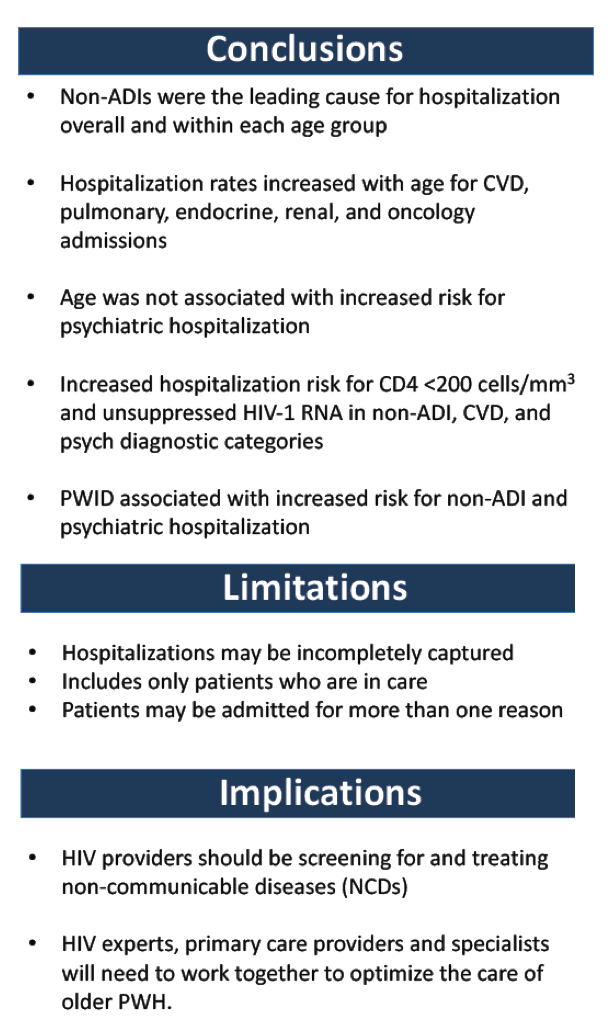
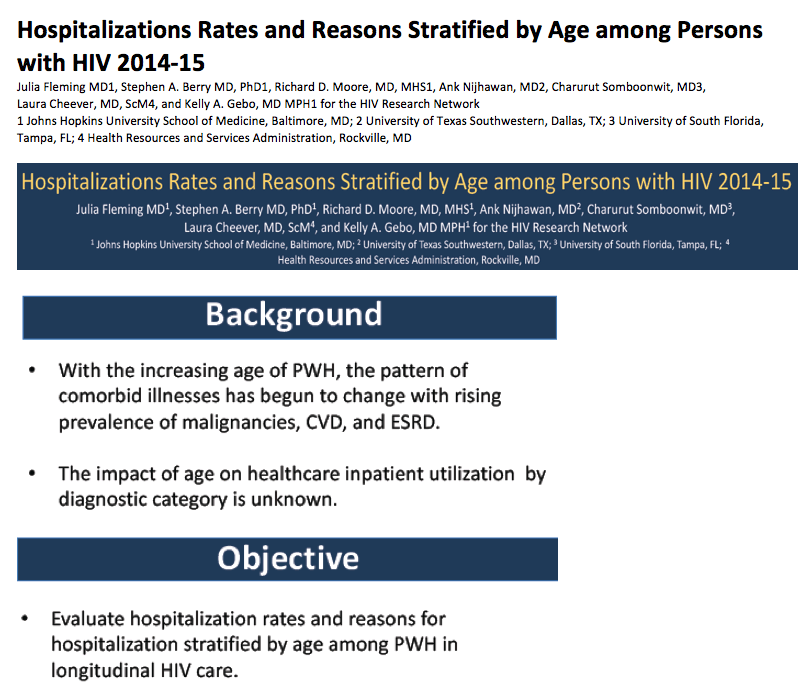
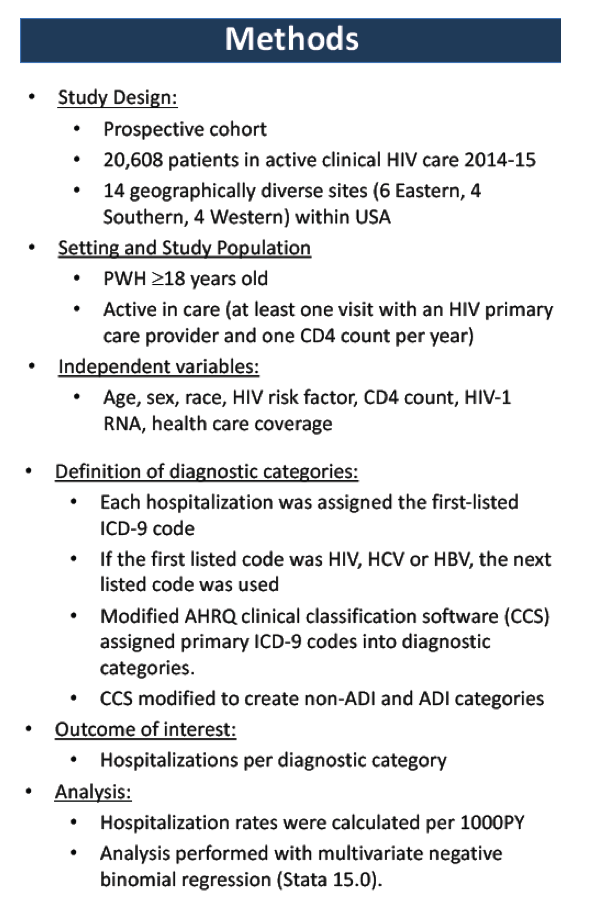
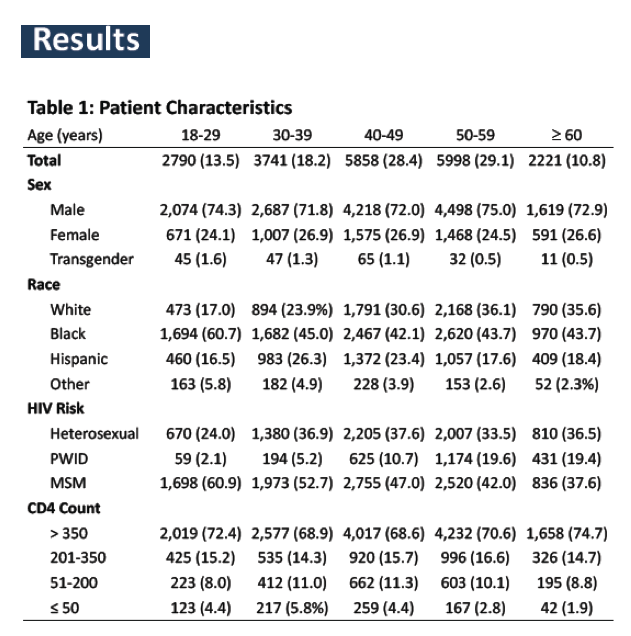
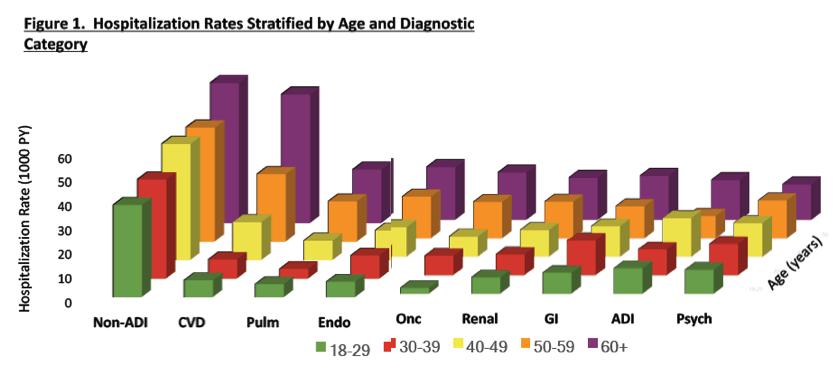
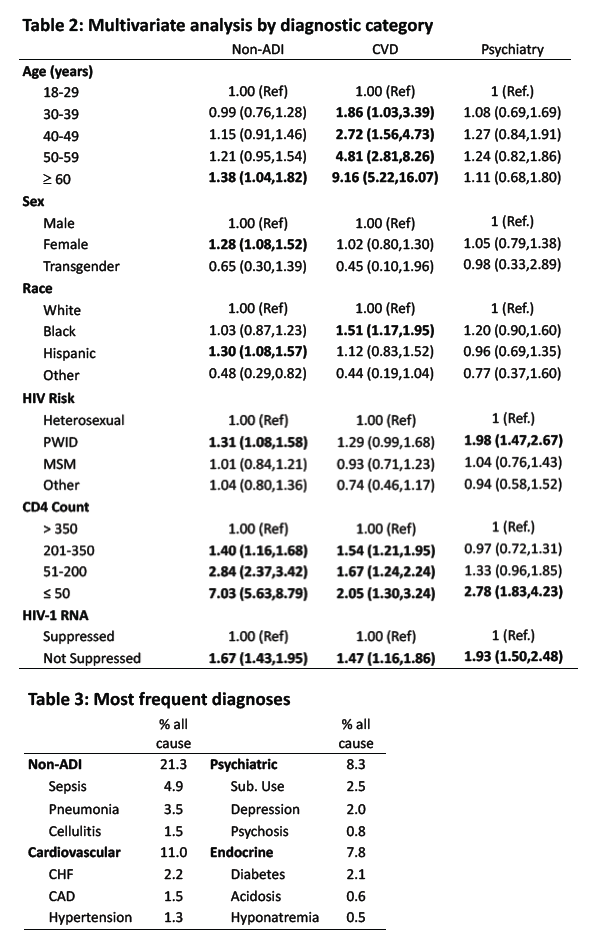
|
| |
|
 |
 |
|
|